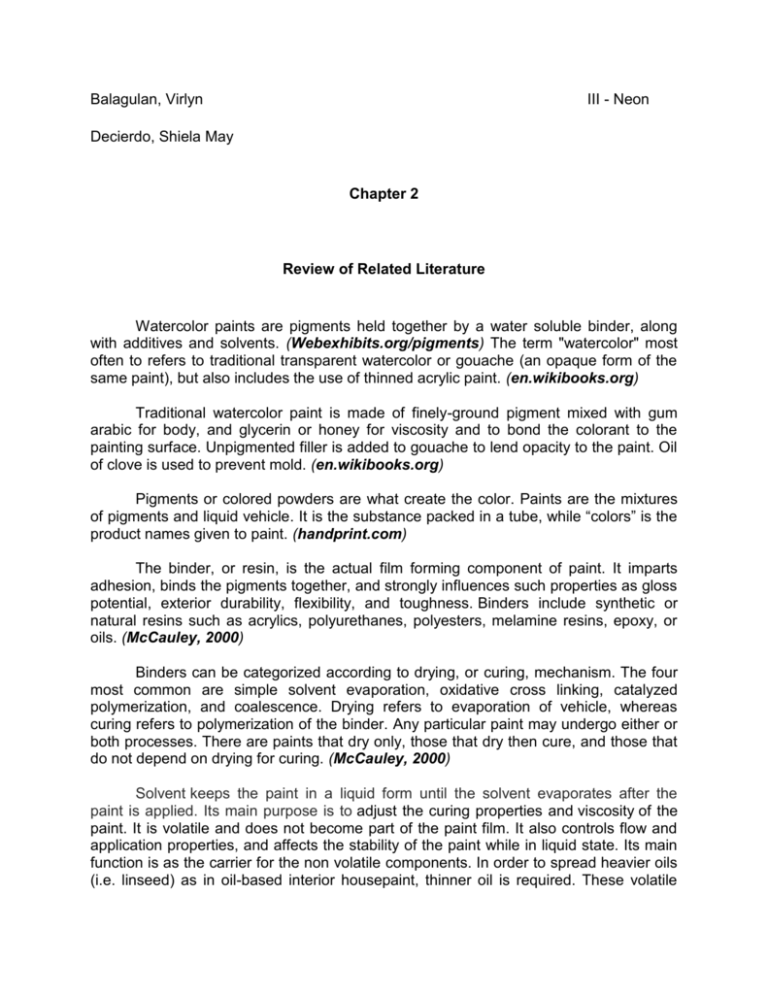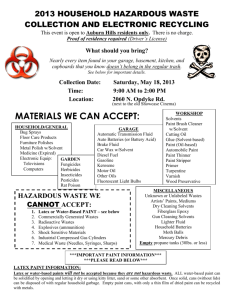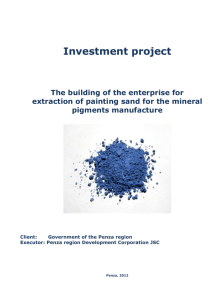balagulan-decierdochapter2_cim_comments
advertisement

Balagulan, Virlyn III - Neon Decierdo, Shiela May Chapter 2 Review of Related Literature Watercolor paints are pigments held together by a water soluble binder, along with additives and solvents. (Webexhibits.org/pigments) The term "watercolor" most often to refers to traditional transparent watercolor or gouache (an opaque form of the same paint), but also includes the use of thinned acrylic paint. (en.wikibooks.org) Traditional watercolor paint is made of finely-ground pigment mixed with gum arabic for body, and glycerin or honey for viscosity and to bond the colorant to the painting surface. Unpigmented filler is added to gouache to lend opacity to the paint. Oil of clove is used to prevent mold. (en.wikibooks.org) Pigments or colored powders are what create the color. Paints are the mixtures of pigments and liquid vehicle. It is the substance packed in a tube, while “colors” is the product names given to paint. (handprint.com) The binder, or resin, is the actual film forming component of paint. It imparts adhesion, binds the pigments together, and strongly influences such properties as gloss potential, exterior durability, flexibility, and toughness. Binders include synthetic or natural resins such as acrylics, polyurethanes, polyesters, melamine resins, epoxy, or oils. (McCauley, 2000) Binders can be categorized according to drying, or curing, mechanism. The four most common are simple solvent evaporation, oxidative cross linking, catalyzed polymerization, and coalescence. Drying refers to evaporation of vehicle, whereas curing refers to polymerization of the binder. Any particular paint may undergo either or both processes. There are paints that dry only, those that dry then cure, and those that do not depend on drying for curing. (McCauley, 2000) Solvent keeps the paint in a liquid form until the solvent evaporates after the paint is applied. Its main purpose is to adjust the curing properties and viscosity of the paint. It is volatile and does not become part of the paint film. It also controls flow and application properties, and affects the stability of the paint while in liquid state. Its main function is as the carrier for the non volatile components. In order to spread heavier oils (i.e. linseed) as in oil-based interior housepaint, thinner oil is required. These volatile substances impart their properties temporarily—once the solvent has evaporated or disintegrated, the remaining paint is fixed to the surface. It can include such hazardous ingredients. (en.wikipedia.org) Besides the three main categories of ingredients, paint can have a wide variety of miscellaneous additives, which are usually added in very small amounts and yet give a very significant effect on the product. Some examples include additives to modify surface tension, improve flow properties, improve the finished appearance, increase wet edge, improve pigment stability, impart antifreeze properties, control foaming, control skinning, etc. Other types of additives include catalysts, thickeners, stabilizers, emulsifiers, texturizers, adhesion promoters, UV stabilizers, flatteners (deglossing agents), biocides to fight bacterial growth, and the like. Additives normally do not significantly alter the percentages of individual components in a formulation. (en.wikipedia.org) Volatile organic compounds (VOCs) in paint are considered harmful to the environment and -to people who work with them on a regular basis. VOCs are typically not acutely toxic but, instead, have compounding long-term health effects. (en.wikipedia.org) Plants can provide vivid colors without the harmful additives that may pollute water system when they are poured down the drain. This gave us the idea of making water color paint from common plants found in the area. For various reasons we chose three colors, red (from the tomato fruit), green (from malunggay leaves), and yellow (from turmeric rhizome) water colors paints to be produced from different kinds of plants. Tomato (Solanum lycopersicum) is a delicious, nutritious fruit, more widely known as a vegetable. Botanically, a tomato is the ovary of a flowering plant; therefore it is a fruit, or, more specifically, a berry. However, since it’s not as sweet as other fruits and is most often served in salads or as a main dish - most people refer to it as a vegetable. (tomato.org) Malunggay (Moringa oleifera) is the most widely cultivated species of the genus Moringa, which is the only genus in the family Moringaceae. It is an exceptionally nutritious vegetable tree with a variety of potential uses. (en.wikipedia.org) Moringa is loaded with nutrients. Each ounce of Moringa contains seven times the Vitamin C found in oranges, four times the Vitamin A of carrots, three times the iron of spinach, four times as much calcium as milk and three times the potassium of bananas. The leaves, pods and flowers of this versatile tree are all edible, each with its own flavor. They can be served fresh with meals, or be reduced to powder and used as a food supplement. (malunggay.com) Turmeric (Curcuma longa) or luyang dilaw in Filipino) plants are gathered annually for their rhizomes, and propagated from some of those rhizomes in the following season. (en.wikipedia.org) It is used as condiment and food coloring. It also used to dye fabrics. Aside from these uses, turmeric is highly valued for its medicinal properties. (wayofdesign.com) With these particular plants, we are going to try and make water color paints without the harmful substances that commercial made water color paints have.









